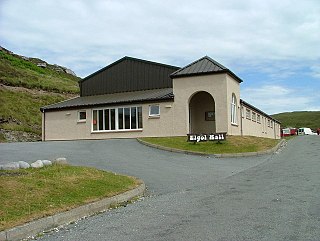
Ragnar Lodbrok or Lothbrok, according to numerous legends and sagas about his life, was a Norse Viking king. He is known from Viking Age Old Norse poetry, sagas, as well as contemporary chronicles. His life and personage are according to modern academia historically dubious. According to traditional literature, Ragnar distinguished himself by many raids against Eastern Europe, Francia, Ireland, and Britain during the 9th century. His legendary kingdom is said to have included parts of Denmark, Norway, and Sweden.

Deira was an Anglo-Saxon kingdom in Northern England. The kingdom was previously inhabited by Britons and was first recorded when Anglian warriors invaded the Derwent Valley in the latter half of the fifth century. Deira's territory extended from the Humber to the Tees, and from the sea to the western edge of the Vale of York. It later merged with the kingdom of Bernicia, its northern neighbour, to form the kingdom of Northumbria.
Ælla or Ælle is the first known king of the Anglian kingdom of Deira, which he ruled from around 560 until his death.
Æthelric was supposedly a King of Deira. He is thought to have succeeded Ælla of Deira, but his existence is historically obscure.

Björn Ironside was a historical Norse Viking chief and Scandinavian king. According to the 12th- and 13th-century Scandinavian histories, he was the son of the notorious Viking king Ragnar Lodbrok and himself a legendary king of Sweden. He lived in the 9th century, being securely dated between 855 and 858. Björn Ironside is said to have been the first ruler of the Swedish Munsö dynasty. In the early 18th century, a barrow on the island of Munsö was claimed by antiquarians to be Björn Järnsidas hög or Björn Ironside's barrow.
Ivar the Boneless, also known as Ivar Ragnarsson, was a Viking leader who invaded Anglo-Saxon England. According to Tale of Ragnar Lodbrok, he was the youngest son of Ragnar Loðbrok and his third wife Aslaug. His half-brothers and brothers included Björn Ironside, Halfdan Ragnarsson, Hvitserk, Sigurd Snake-in-the-Eye and Ubba.
Sigurd Snake-in-the-eye was a Viking warrior and Danish King active from the mid to late 9th Century. According to multiple Saga sources and Scandinavian histories he is one of the sons of the legendary Viking Ragnar Lodbrok and Aslaug.
Aelle, also seen as Ælle, Aella, or Ælla may refer to:

The blood eagle is a ritual method of execution, detailed in late skaldic poetry. According to the two instances mentioned in the Sagas, the victims were placed in a prone position, their ribs severed from the spine with a sharp tool, and their lungs pulled through the opening to create a pair of "wings". There is continuing debate about whether the rite was a literary invention, a mistranslation of the original texts, or an authentic historic practice.

Eupithecia is a large genus of moths of the family Geometridae. There are hundreds of described species, found in all parts of the world, and new species are discovered on a regular basis.

The lime-speck pug is a moth of the family Geometridae. It is a common species throughout the Palearctic region, the Near East and North Africa.

The common pug(Eupithecia vulgata) is a moth of the family Geometridae. It is a common species across the Palearctic region, the Near East and North Africa. It ranges from the Atlantic coast of Ireland and Portugal across Europe, the Middle East and Central Asia to the Russian Far East (Priamurje) and Korea.

The juniper pug or juniper looper is a moth of the family Geometridae. The species was first described by Michael Denis and Ignaz Schiffermüller in 1775. It is found throughout the Palearctic and Nearctic regions and the Near East.
Ælla was King of Northumbria, a kingdom in medieval England, during the middle of the 9th century. Sources on Northumbrian history in this period are limited, and so Ælla's ancestry is not known and the dating of the beginning of his reign is questionable.

The Vikings is a 1958 epic historical fiction swashbuckling film directed by Richard Fleischer and filmed in Technicolor. It was produced by Jerry Bresler and stars Kirk Douglas. It is based on the 1951 novel The Viking by Edison Marshall, which in turn is based on material from the sagas of Ragnar Lodbrok and his sons. Other starring roles were taken by then husband-and-wife Tony Curtis and Janet Leigh as well as Ernest Borgnine. The film made notable use of natural locations in Norway. It was mostly filmed in Maurangerfjorden and Maurangsnes, captured on film by cinematographer Jack Cardiff, although Aella's castle was the real Fort de la Latte in north-east Brittany in France, and shooting was also situated at the Lim Bay (Fiord), in Croatia.

Osberht was king of Northumbria in the middle of the 9th century. Sources on Northumbrian history in this period are limited. Osberht's descent is not known and the dating of his reign is problematic.

Elgol is a village on the shores of Loch Scavaig towards the end of the Strathaird peninsula in the Isle of Skye, in the Scottish Highlands.
Aella was one of Hippolyte's Amazons in Greek mythology. She was one of the warriors who fought Hercules when he came for Hippolyta's Girdle. She was known for fighting well with a double-axe.

Eupithecia venosata, the netted pug, is a moth of the family Geometridae. It was first described by Johan Christian Fabricius in 1787. It is found across the Palearctic ecozone from Portugal and Morocco in the west to the Lake Baikal in Siberia and Afghanistan and Pakistan in the east.
Eupithecia variostrigata is a moth in the family Geometridae. It is widespread in the western Palaearctic, ranging from Spain to the western Pamirs in the east.











